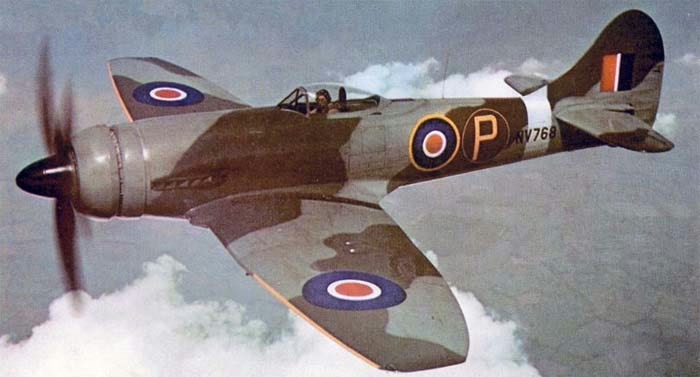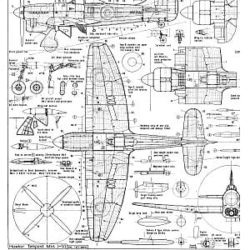Hawker Tempest History
The Hawker Tempest was another fearsome machine unleashed by Hawker. It combined all the hard-hitting attributes of the earlier Hawker Typhoon with exceptional high-altitude performance.
Shortcomings of the Typhoon at higher altitudes led Sydney Camm to reconsider his design. The problem – unknown at the time – was compressibility, whereby air passed over airfoils at nearly the speed of sound. Because the Typhoon employed a particularly thick wing, it gave rise to constant buffeting at high speed. In 1941 Camm suggested fitting the aircraft with a thinner airfoil of elliptical design. A new engine, the radial Centaurus, was also proposed.
Design went ahead with the new Typhoon II, as it was called, which was continuously modified over time. The thinner wing necessitated the fuel tanks being transferred to the fuselage, which was lengthened 2 feet and given a dorsal spine. In light of these modifications, Hawker gave it an entirely new designation: Tempest. It was then decided to fit the Mk V version with the tested Napier Sabre II engine because of delays with the Centaurus engine.
The first Hawker Tempest fighters were delivered to No 3 Squadron Royal Air Foce (RAF) and No 486 Squadron Royal New Zealand Air Force (RNZAF) in April 1944, and flew many cross-Channel sorties before and after the invasions of Normandy.
In service the Hawker Tempest continued the ground-attack tradition of the Typhoon, for it easily handled 1,000-pound bombs and a host of rockets. However, because of its new wing, it also possessed superb high-altitude performance. The Tempest flew so fast that it became one of few Allied fighters able to intercept the German V-1 rocket bombs, claiming 638 of the 1,771 destroyed. The Tempest could also successfully tangle with the Messerschmitt Me 262 Schwalbe jets, destroying 20 of those formidable fighters.
Eight hundred Hawker Tempest Vs were built. The Mk VI (one hundred and forty-two built) was an improvement model with Sabre V engine, but did not see service until after the war. Neither did the Tempest II, chronologically the last serving version, which was powered by a 2,520 hp Bristol Centaurus V or VI radial engine. Four hundred and seventy-four Tempest IIs were completed, this model remaining in RAF service until 1951 and with the Indian and Pakistan air forces until 1963. The Hawker Tempest II was the last piston-engine fighter-bomber flown by the Royal Air Force, and it served as the basis of the superb Hawker Sea Fury. The Tempest V and VI were relegated to target-towing duties in the early post-war period.









